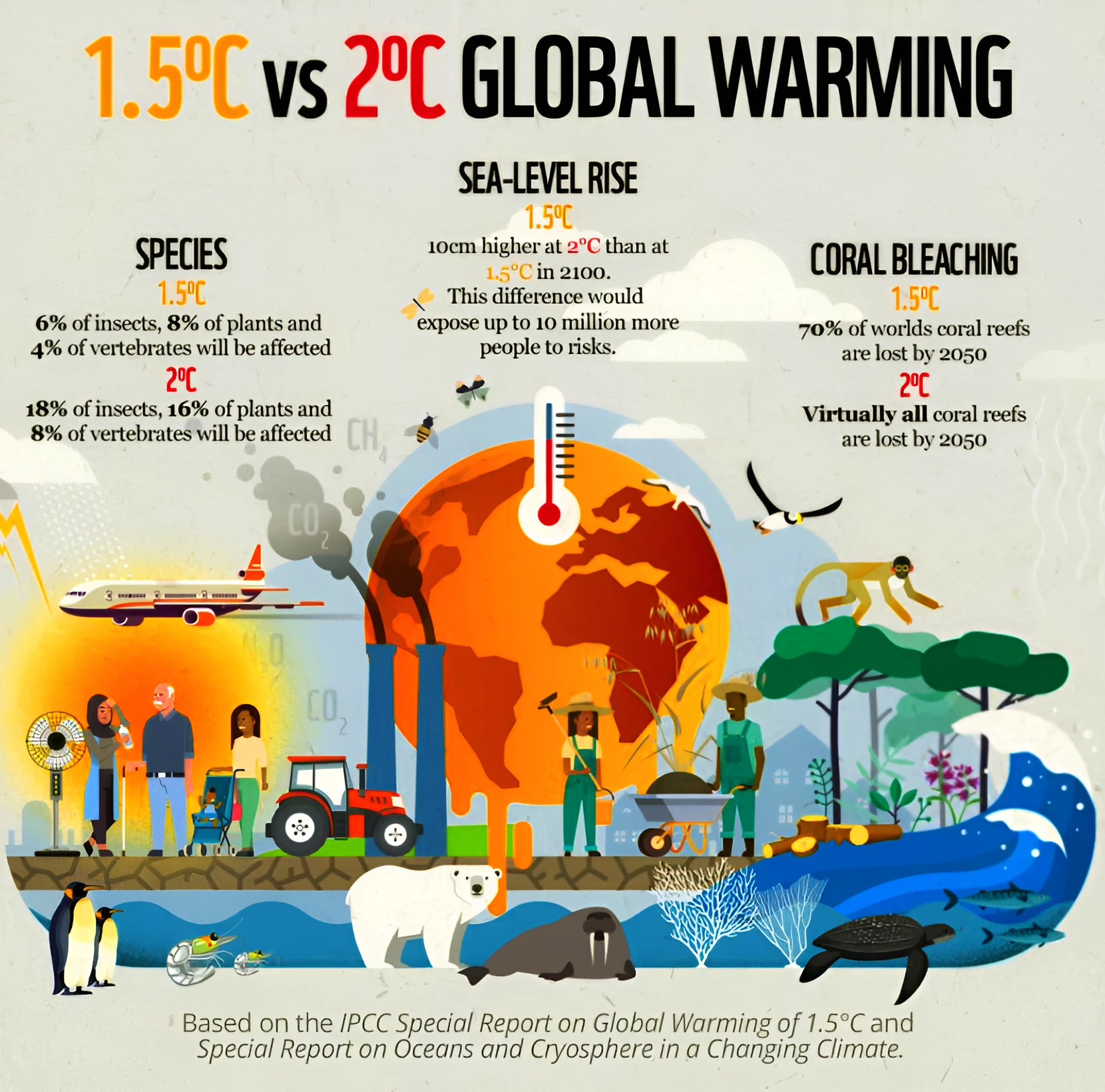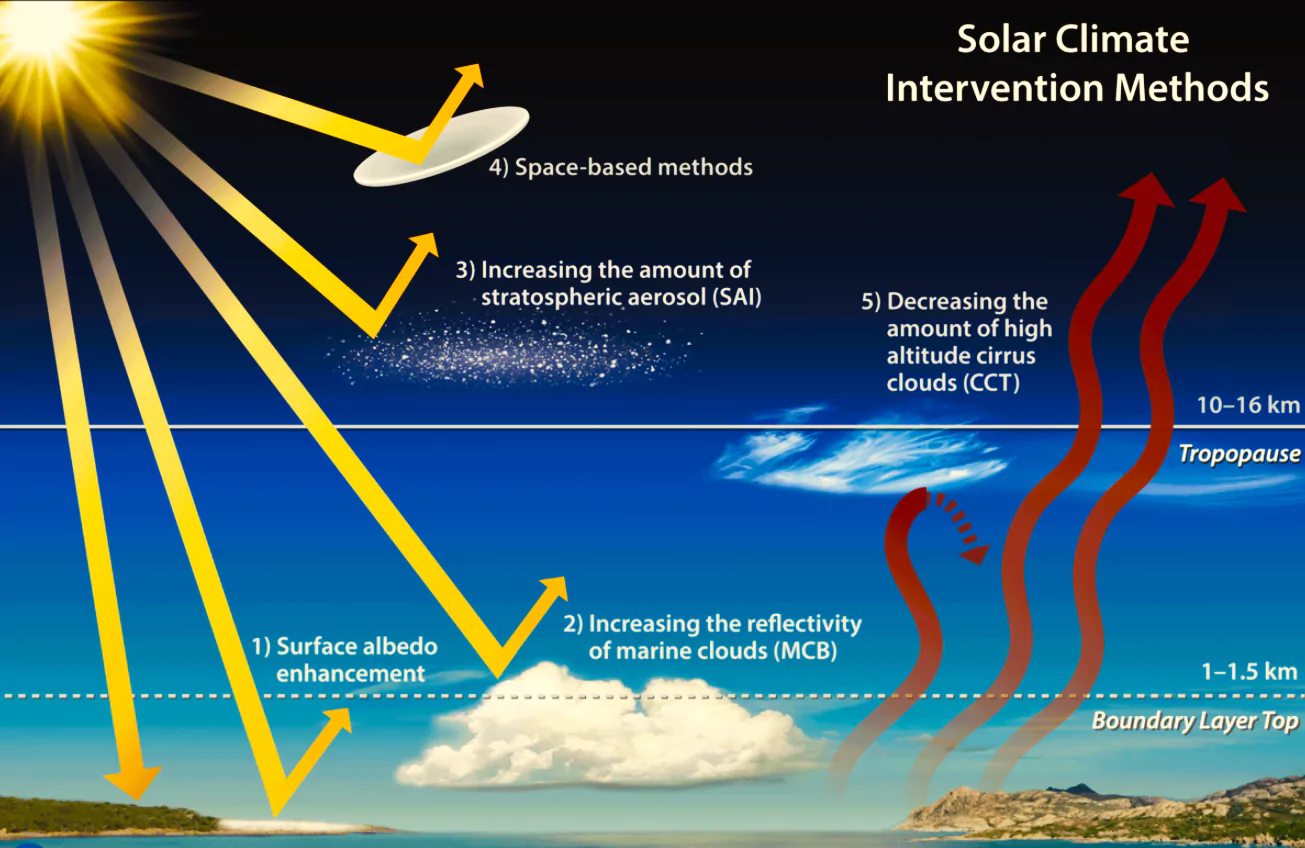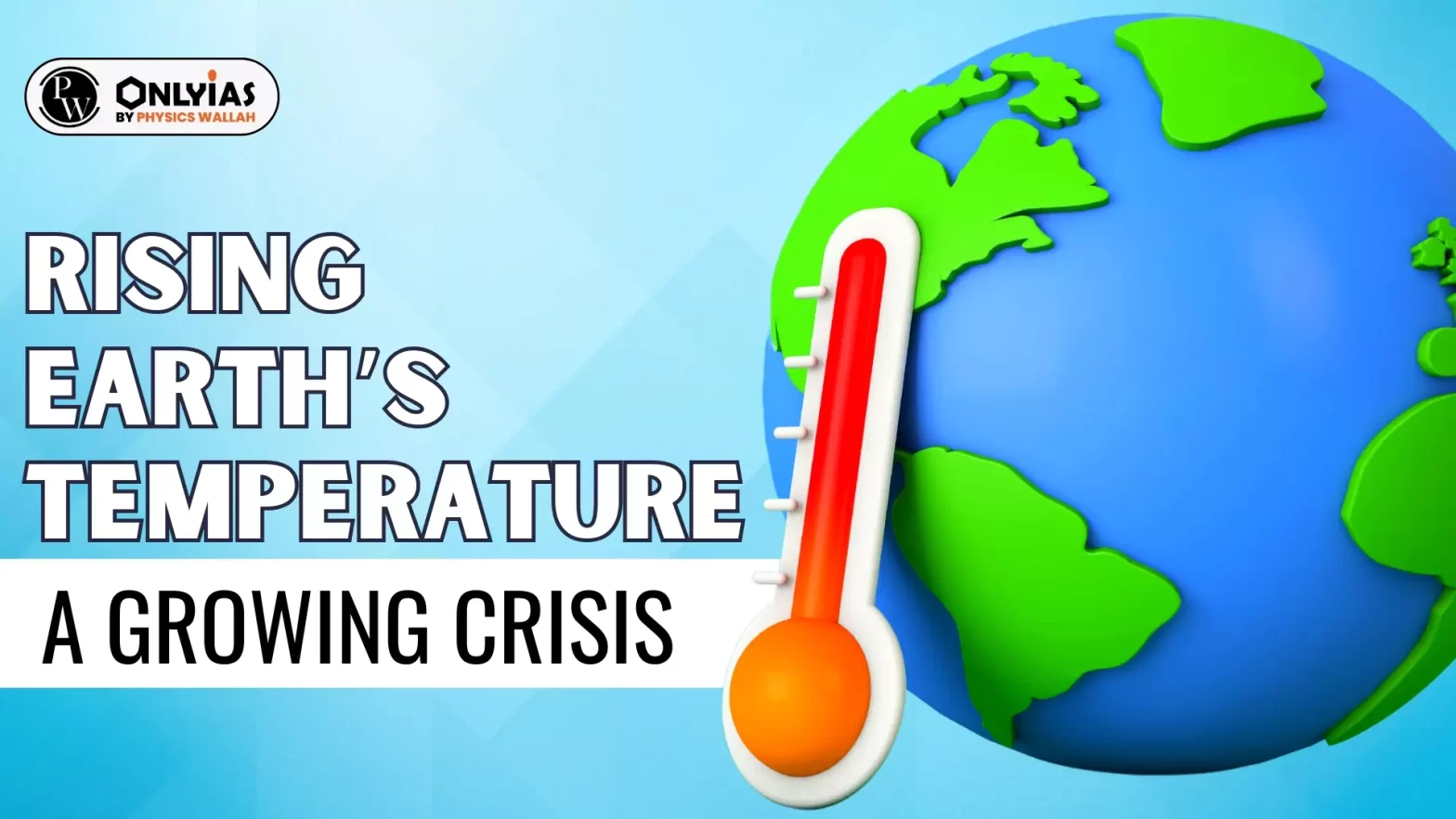Context:
This article is based on the news “Warming up to climate change: What is the 1.5 degree Celsius threshold, and what happens when we breach it?” which was published in the Indian Express. According to NASA, the average global temperature on Earth has increased by at least 1.1 degrees Celsius since 1880.
2023 As Warmest Year on Record
- ‘2023 Warmest Year: According to Europe’s Copernicus Climate Change Service (C3S), 2023 was the warmest year since records began in 1850, beating the previous record of 2016.
- 2023 could have been the hottest year in the 174-year observational record and probably the hottest in 125,000 years.
Factors for Rising Earth’s Temperature:
- Natural Factors: Earth has cycled through many cool and warm periods in its 4.5 billion-year history. They have been caused by several natural factors like:
- Solar Energy: It varies over time and affects the climate.
- Ocean Circulation: The movement of heat around the world by currents. For instance, around 12,000 years ago, major changes in Atlantic circulation turned the Northern Hemisphere into a frigid state.
- Volcanic Activity: Eruptions lead to the release of gases and dust high into the atmosphere, which reflects back the sunrays and results in short-term cooling of Earth.
- The opposite can happen too. For example, a dramatic period of global warming 56 million years ago was triggered due to a volcanic eruption that released large amounts of carbon dioxide (CO2), global temperatures soared by up to five degree Celsius.
- Continental Drift: The theory proposes that Pleistocene glaciations were initiated when the North Pole reached its present position in the middle of the Arctic Ocean, and Antarctica became coincident with the South Polar Region.
- Anthropogenic Factors: According to a March 2023 Synthesis Report by the Intergovernmental Panel on Climate Change (IPCC), human activities, principally through greenhouse gas emissions, have unequivocally caused global warming.
- The main drivers of these emissions are energy use, land use, and the consumption and production of goods.
- Fossil fuel combustion and industrial processes contributed 78% of all emissions since 1970.
- Sectors of the economy responsible for most of this include electricity and heat production, agriculture, forestry, and land use,industry (21%), transportation etc.
- Increasing Greenhouse Gas (GHG) Emissions: According to the IPCC Sixth Assessment Report (AR6), in 2019, global net anthropogenic GHG emissions were at 59 gigatonnes of carbon dioxide equivalent (GtCO2e), 54 per cent higher than in 1990.
About Greenhouse Gases (GHG)
- Greenhouse gases (GHGs) are those gases in the Earth’s atmosphere that trap heat. They allow sunlight to pass through the atmosphere but prevent the heat from escaping.
- Essentially, GHGs act like a blanket that envelopes our planet and insulates Earth from the cold of space.
- This process of maintaining a warmer temperature is called the greenhouse effect.
- Key GHGs: Water vapour, carbon dioxide, methane, ozone, and nitrous oxide.
- Anthropogenic GHG:
- Chlorofluorocarbons (CFCs): Once used widely as a refrigerant in air conditioners, freezers and refrigerators, these chemicals damage the ozone layer and are really potent GHGs.
- Compared to carbon dioxide, CFCs can produce more than 10,000 times as much warming.
- Hydrofluorocarbons (HFCs): It is the replacement of CFCs, they don’t harm the ozone layer but are power GHGs.
|
The 1.5 Degree Celsius Limit to Earth Temperature

- Paris Agreement 2015: In 2015, the Paris Agreement was signed by 195 countries, which pledged to limit the Earth’s temperature to well below 2 degree Celsius above pre-industrial levels by the end of the century.
- Aim of Paris Agreement 2015: To limit the temperature increase to 1.5 degrees Celsius above pre-industrial levels by 2100 to prevent the planet from slipping into further climate crises.
- Pre- Pre-Industrial Level: The Paris Agreement didn’t specify these levels but scientists generally consider the years from 1850 to 1900 as a baseline.
-
Why 1.5 Degrees Celsius?
-
- Even global warming of 1.5 degrees Celsius above the preindustrial average would lead to high risks for some regions and vulnerable ecosystems, therefore, it was decided to set the 1.5 degrees Celsius limit as a “defence line”.
-
What Happens When We Breach the Threshold?
- According to the IPCC, the breach would lead to increased frequency, intensity and heavy precipitation droughts in many regions.
- Moreover, higher global temperatures would warm oceans, resulting in stronger hurricanes, wildfires, rapid sea ice melt, and rising sea levels.
-
How Close Are We to Breaking the Threshold?
-
Have We Already Breached the 1.5 degree Celsius Limit?
-
- According to C3S, about 50% of days in 2023 were more than 1.5 degrees Celsius warmer than the pre-industrial levels and two days in November were, for the first time, more than 2 degrees Celsius warmer.
- However, this does not mean that the planet has breached the 1.5-degree and 2-degree Celsius thresholds as those limits refer to long-term warming over a period of 20-30 years, on average.
Challenges Associated With Rising Earth’s Temperature
- Melting Sea Ice: The monthly average Antarctic sea ice extent in July 2022 reached 15.3 million sq km and it was 7 per cent below the 1991-2020 average.
- Changes in sea ice can disrupt global climate patterns and ecosystems, influence weather systems and potentially lead to more extreme weather events.
- For instance, it threatens Arctic ecosystems, affecting polar bears, seals, and other species dependent on ice for their habitat and food sources.
- Disappearance of Glaciers: In the 3rd Pole, the region encompassing the Himalaya-Hindu Kush mountain range and the Tibetan Plateau in Central Asia, over 509 small glaciers disappeared in the past 50 years and even the biggest ones are shrinking rapidly.
- Melting Glaciers contribute to rising sea levels, threatening coastal communities and low-lying areas.
- This can lead to increased flooding and displacement of populations. As glaciers diminish, water supply for communities downstream may be compromised, affecting agriculture and drinking water.
- Accelerated Sea Level Rise: Every year, the sea rises 0.13 inches and sea level rise is accelerating and projected to rise by a foot by 2050.
- According to the Intergovernmental Panel on Climate Change (IPCC) report, the oceans may rise between 10 and 30 inches by 2100 with temperatures warming 1.5 °C.
- Higher sea levels contribute to coastal erosion, jeopardizing infrastructure, homes, and ecosystems.
- Vulnerable coastal regions face increased risk of flooding and storm surges. They are further causing shifts of marine biodiversity towards higher latitudes and also causing coral bleaching.
- For instance, four different species, the Atlantic rock crab (crustacean), Atlantic cod (fish), sharp snout seabream (fish) and the common eelpout (fish) could be displaced from as much as a quarter of their current ranges by 2100 as they shifted toward higher latitudes.
- Rising Extreme Weather Events (EWE): Extreme Weather Events caused serious damage to all inhabited continents, exacerbating food insecurity population displacement, and impacts on vulnerable people.
- For example, the early onset of intense heatwaves over India and Pakistan from March to May 2022 (made 30 times more likely) and floods in Pakistan in August (Increased rainfall intensity by 50 per cent).
- Widespread Wildfires: Warmer temperatures create drier conditions, increasing the frequency and intensity of wildfires. This poses a threat to ecosystems, biodiversity, and human communities.
- For example, nearly three billion animals were killed or displaced by Australia’s devastating wildfires in 2019 and 2020,
- Longer, More Intense Heat Waves: Prolonged and intense heat waves can lead to heat-related illnesses and deaths, especially in vulnerable populations. Extreme heat can negatively affect crop yields and agricultural productivity, leading to food insecurity. Heat stress on livestock is also a concern.
Strategies For Mitigation of Climate Change
- Ensure Net-Zero Targets: More than 140 countries, including the biggest polluters (China, the United States, India and the European Union) have set a net-zero target, covering about 88% of global emissions.
- International Initiatives: More than 90 countries have set net-zero emissions targets, and there is a need for a mechanism to support and ensure these climate change pledges will be met.
- For example, OECD International Programme for Action on Climate (IPAC) supports country progress towards net-zero GHG emissions and a more resilient economy by 2050.
- Climate Mitigation and Adaptation: Reducing the emission of GHG into the atmosphere to make the impacts of climate change less severe.
- According to the Emissions Gap Report 2022 released by UNEP, emissions must fall by 45 percent for 1.5°C, 2030. Emissions must continue to decline rapidly after 2030 to avoid exhausting the remaining atmospheric carbon budget.
- Sustainable Agriculture: To mitigate the adverse impacts of climate change on agriculture and ensuring food security, developing and promoting the cultivation of climate-resilient crop varieties, sustainable farming practices etc. are essential.
- For instance, according to the Indian Council of Agricultural Research (ICAR), crops grown in the Himalayan region will be severely affected by the end of the century. Thus, farmers in Uttarakhand are rethinking traditional agricultural practices and experimenting with new crops and species and branching into animal husbandry, poultry and fish farming.
 Emerging Technology to Tackle Climate Change: Technology plays a crucial role in mitigating climate change by providing innovative solutions to reduce greenhouse gas emissions and mitigate damage to the planet.
Emerging Technology to Tackle Climate Change: Technology plays a crucial role in mitigating climate change by providing innovative solutions to reduce greenhouse gas emissions and mitigate damage to the planet.-
- For example, using solar geoengineering which includes a set of methods aimed at cooling the Earth in order to counteract the warming effects of increases in GHGs.
- Controlling Industrial Emissions: Led by Germany and Chile, Leaders gathered on the second day of the 28th Conference of Parties (COP28) to the United Nations Framework Convention on Climate Change to formally launch the Climate Club initiative aimed at cooperation between countries in decarbonising the industrial sector.
- However, India is not a member of the Climate Club.
Also Read:
To get PDF version, Please click on "Print PDF" button.


 Emerging Technology to Tackle Climate Change: Technology plays a crucial role in mitigating climate change by providing innovative solutions to reduce greenhouse gas emissions and mitigate damage to the planet.
Emerging Technology to Tackle Climate Change: Technology plays a crucial role in mitigating climate change by providing innovative solutions to reduce greenhouse gas emissions and mitigate damage to the planet.